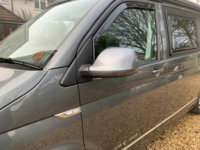Just for completeness if anyone else does something similar, this is the good stuff
Fibreglass repair kit grp Mat + Resin1kg Lloyds approved Boat Fibre glass | eBay
And this is the cack that didn't work
1kg Low Viscosity Ultra-Clear Epoxy Resin | eBay
Fibreglass repair kit grp Mat + Resin1kg Lloyds approved Boat Fibre glass | eBay
And this is the cack that didn't work
1kg Low Viscosity Ultra-Clear Epoxy Resin | eBay



